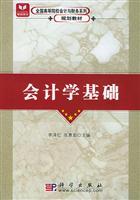yang bang hua shi wei (2 résultats)
Type d'article
- Tous les types d'articles
- Livres (2)
- Magazines & Périodiques
- Bandes dessinées
- Partitions de musique
- Art, Affiches et Gravures
- Photographies
- Cartes
-
Manuscrits &
Papiers anciens
Etat
- Tous
- Neuf
- Ancien ou d'occasion
Reliure
- Toutes
- Couverture rigide
- Couverture souple
Particularités
- Edition originale
- Signé
- Jaquette
- Avec images (1)
- Sans impression à la demande
Pays
Evaluation du vendeur
-
21 century Vocational planning materials Financial Management Series: Fundamentals of Accounting (for non-accountants)(Chinese Edition)
Edité par Tsinghua University Press. Beijing Jiaotong Univer, 2005
ISBN 10 : 7810826182ISBN 13 : 9787810826181
Vendeur : liu xing, Nanjing JiangSu, JS, Chine
Livre
paperback. Etat : New. Language:Chinese.Paperback. Pages Number: 277 Publisher: Tsinghua University Press. Beijing Jiaotong University Press. Pub. Date :2005-10-01. accounting-based accounting system to the latest enterprise and the specific accounting standards. based mainly introduces the basic theory of corporate accounting. basic economic services. the basic method of accounting and basic skills. According to Higher Business Management class of non-accounting students on the demand characteristics of academic k.
-
Colleges and universities applied Featured planning materials: Microcomputer Principle and Interface Technology Practical Guide (2nd Edition)(Chinese Edition)
ISBN 10 : 7302299110ISBN 13 : 9787302299110
Vendeur : liu xing, Nanjing JiangSu, JS, Chine
Livre
paperback. Etat : New. Ship out in 2 business day, And Fast shipping, Free Tracking number will be provided after the shipment.Paperback. Pub Date: 2013 Pages: 392 Language: Chinese Publisher: Tsinghua University Press Institutions of Higher Learning in the application characteristics planning materials: Microcomputer Principle and Interface Technology Practical Guide (2nd Edition) is divided into 10 chapters. the system comprehensive introduction to the basic principles and applications of micro-computer technology. specifically includes microcomputer overview. microprocessor. 80x86 addressing mode and instruction. assembly language programming. memory. input and output interfaces. interrupt system. programmable interface chip. the analog interface and bus. College application characteristics textbook: Microcomputer Principle and Interface Technology Practical Guide (2nd Edition) to the basic theory - for example - training the main line organizations to prepare. most of the chapters are set up small case training. in order to reader to grasp the focus of each chapter and to improve the practical application and analysis capabilities. Book structure is clear. easy to learn and easy to teach. examples of rich. easy to operate. to apply what they have learned to focus on capacity. on confusing and practical content Highlights and explain. This book can be used as ordinary institutions of higher learning-related course materials. but also as a reference tutorial of all kinds of engineering and technical personnel and other self-learners. Contents: Chapter 1 Overview 1.2.3 The main performance of the components and functions of the computer course of development of the overview of the development of the computer 1.1.1 1.1 1.1.2 microcomputers the development process of the development of microprocessor 1.2 1.2.1 Introduction 1.2.2 CPU microcomputer Classification 1.3.4 of the Indicator 1.3 microcomputer 1.3.1 1.3.2 Features 1.3.3 microcomputer computer's main technical indicators 1.3.5 Application 1.4 Micro Systems 1.4.1 Composition 1.4.2 Working Process 1.5 computer data representation and Coding 1.5.1 common number system 1.5.2 number system conversion between 1.7 Summary 1.8 1.6 small case of fixed-point and floating-point 1.5.3 of commonly used code system 1.5.4 1.5.5 BCD code 1.5.6 ASCII code training Problem Chapter 2 microprocessor 2.1 80.868.088 microprocessors 2.1.1 Introduction 2.1.2 The internal structure 2.1.3 2.1.4 pin programming structure and function 2.1.5 Memory Organization 2.1.6 Input / Output (IO) organization 2.1. 7 System Configuration 2.1.8 Basic Timing 2.2 80x86 microprocessor 2.2.1 Basic structure 2.2.2 programming structure 2.2.3 Pin Functions 2.2.4 Basic Timing 2.3 Small Case Training 2.4 Summary 2.5 Exercises Chapter 3 80X86 addressing immediately Addressing 3.1.2 Register Addressing manner and instruction addressing modes 3.1 3.1.1 3.1.3 3.1.4 Memory Addressing port addressing other addressing modes 3.1.5 3.1.6 80386 microprocessor addressing modes Introduction 3.2 instruction 3.2.1 data transfer instruction 3.2.2 arithmetic instructions 3.2.3-bit operating instructions 3.2.4 string manipulation instructions and repeat prefix 3.2.5 3.2.6 flag control transfer instruction processing and CPU control Instructions 3.2.7 3.3 small case of the 80386 microprocessor instruction training 3.4 Summary 3.5 Exercises Chapter 4 Assembly Language Programming 4.1 assembly language syntax 4.1.1 statement format 4.1.2 4.1.3 Types and Structure of assembly language statement in the expression 4.2 directive of the operator in the type 4.1.4 assembly language 4.2.1 Symbol definition directives 4.2.2 variables define directive 4.2.3 Definition Directives 4.2.4 process definition the directive 4.2.5 module defines the communication directive 4.3 macros and conditional assembly 4.3.1 macros 4.3.2 conditional assembly the 4.4 DOS function calls and-BIOS interrupt call Introduction 4.4.1 DOS function calls 4.4.2 ROMBIOS the interrupt call Profile 4.



